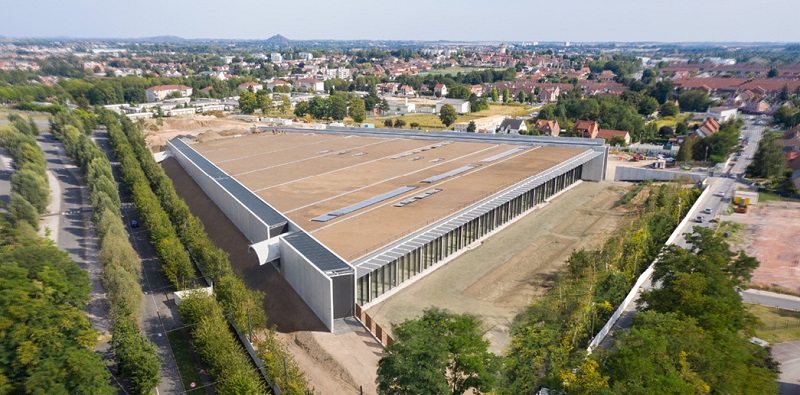RSHP conservation and collection facility for the Louvre, France

|
| RSHP's conservation and collection facility, the Louvre, France. Image courtesy of Rogers Stirk Harbour + Partners. |
On Tuesday 8 October 2019, Rogers Stirk Harbour + Partners celebrated the completion and inauguration of the new Conservation and Collection Facility for The Louvre in Liévin, northern France. The event included a behind-the-scenes tour for invited guests of an otherwise private facility.
The facility is in the commune of Liévin, Pas-de-Calais, 120 miles from Paris. It is a new phase for both the Louvre and for the local area. Being previously an industrial town, Liévin is now an important centre for art research and conservation – in line with the local authority's ongoing efforts to develop and revitalise this former mining basin.
Vulnerability to flooding in the Louvre Palace in Paris and a desire to gather works currently scattered over 68 sites in one space has motivated the Louvre’s requirement for a permanent, robust, off-site facility. Over five years, nearly 250,000 items will be brought together making the facility one of Europe’s largest study and research centres with the intention to change and enable the Louvre’s interaction with its collection in ways that have not yet been possible.
The private facility connects beyond a communal border to the public Louvre Lens museum, a sheer and translucent pavilion designed by architects SANAA. It is one of the most important museums housing the Louvre collection outside Paris. RSHP’s facility is designed to appear as a counterpoint to the Louvre Lens and to compliment the area. It is reminiscent of the military architecture by the French engineer, Vauban – protecting the art using both the landscape and state-of-the-art conservation technology.
Remarkably for a building of its size, rather than dominate the area, it sits environmentally sensitively within it and is elegantly understated. It plays with what is hidden and what is revealed: partially beneath the ground, the one-storey structure with its green roof tapers and slopes into the landscape. The west-facing elevation is tall enough to accommodate a mezzanine floor of administrative offices and the most colossal items of the Louvre’s collection. From this end, the building slopes eastwards into the landscape, from 6m to 3m. Grass covered, it appears as a natural slope. Embedded into the earth, it helps to sustainably control the climatic conditions necessary for the preservation of the collection.
Inside is a simple, rational layout dedicated to protecting and studying art. Its backbone is the ‘boulevard of artworks’ measuring nearly 11m-tall, where all transported pieces arrive and pass each other into the storage rooms: the combined length of bespoke shelving is around 16 miles long. The building consists of approx. 18,500 m2 of floor space, of which 9, 600 m2 will be reserved for storing works, and 1,700 m2 for study and conservation treatment.
Along the full-height, glazed west façade of the building, 1,300 m2 of space is dedicated to conservation treatment, study and consulting the collection. The full-height windows bring in natural light for this purpose, with a generous external aluminium grid overhang to deflect sun rays.
The design aims to change and enable study and consultation of the collection in a way which has until now not been possible in any other museum facility. The observation spaces are flexible: rooms may be re-purposed and rearranged with sliding screens. Services have been designed to be discreetly hidden from both outside and inside in a separate space of their own in order to give over all internal space to the art. Overall, the design allows the easy manoeuvring of even the largest pieces in the collection into spaces that can be studied side by side.
Graham Stirk, Senior Design Partner at Rogers Stirk Harbour + Partners, said: “It has been a great honour to be part of this incredible endeavour. Very few clients are as prestigious as the Louvre and even fewer briefs carry more weight than the relocation of one of humanity’s great treasures. The use of simple, elegant forms, marked by a solidity that resonates with the brief create a powerful language of great French fortresses which in this case [has resulted in] a large inclined park which protects the works of art below.”
Jean-Luc Martinez, President-Director of the Musée du Louvre said: “It’s going to be a hive of activity. Imagine, in the space of five years, nearly 250,000 works will be transferred there. It’s the biggest move in the entire history of the Louvre, and perhaps that of museums everywhere. I am proud of the Louvre and its staff for having the audacity to take on such a big adventure. I have also noticed that the world’s biggest museums are paying attention to what we are doing here.”
[edit] About Rogers Stirk Harbour + Partners
Rogers Stirk Harbour + Partners is an international architectural practice based in London. Over the past four decades, RSHP has attracted critical acclaim and awards with built projects across Europe, the Americas, Asia and Australia. The practice is experienced in designing a wide range of building types including: office, residential, transport, education, culture, leisure, retail, civic and healthcare. The quality of its designs has been recognised with some of architecture’s highest awards, including two RIBA Stirling Prizes, one in 2006 for Terminal 4, Madrid Barajas Airport and the other in 2009 for Maggie’s West London Centre.
[edit] About this article
This article was written by Rogers Stirk Harbour + Partners (RSHP). It previously appeared on the RSHP website in October 2019 and can be accessed HERE.
More articles about RSHP projects on Designing Buildings Wiki can be accessed HERE.
[edit] Related articles on Designing Buildings Wiki
- British Museum.
- Conservation and storage facility for the Musée du Louvre.
- Dali Theatre and Museum.
- French new towns.
- Guggenheim Museum, Bilbao.
- RSHP.
- RSHP articles.
- The Louvre.
- Titanic Museum.
--RSHP
Featured articles and news
Latest Build UK Building Safety Regime explainer published
Key elements in one short, now updated document.
UKGBC launch the UK Climate Resilience Roadmap
First guidance of its kind on direct climate impacts for the built environment and how it can adapt.
CLC Health, Safety and Wellbeing Strategy 2025
Launched by the Minister for Industry to look at fatalities on site, improving mental health and other issues.
One of the most impressive Victorian architects. Book review.
Common Assessment Standard now with building safety
New CAS update now includes mandatory building safety questions.
RTPI leader to become new CIOB Chief Executive Officer
Dr Victoria Hills MRTPI, FICE to take over after Caroline Gumble’s departure.
Social and affordable housing, a long term plan for delivery
The “Delivering a Decade of Renewal for Social and Affordable Housing” strategy sets out future path.
A change to adoptive architecture
Effects of global weather warming on architectural detailing, material choice and human interaction.
The proposed publicly owned and backed subsidiary of Homes England, to facilitate new homes.
How big is the problem and what can we do to mitigate the effects?
Overheating guidance and tools for building designers
A number of cool guides to help with the heat.
The UK's Modern Industrial Strategy: A 10 year plan
Previous consultation criticism, current key elements and general support with some persisting reservations.
Building Safety Regulator reforms
New roles, new staff and a new fast track service pave the way for a single construction regulator.
Architectural Technologist CPDs and Communications
CIAT CPD… and how you can do it!
Cooling centres and cool spaces
Managing extreme heat in cities by directing the public to places for heat stress relief and water sources.
Winter gardens: A brief history and warm variations
Extending the season with glass in different forms and terms.
Restoring Great Yarmouth's Winter Gardens
Transforming one of the least sustainable constructions imaginable.























